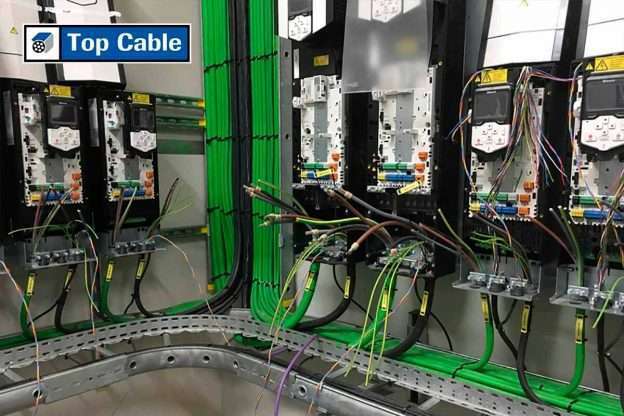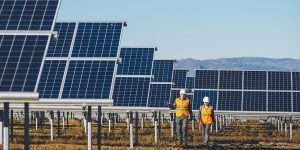The differents electrical cable types has the purpose of transporting electrical energy from one point…
Single-phase vs three-phase cable installations: Key Differences Explained
When carrying out electrical installations, it is important to consider the type of electrical system that will be used. The distribution of energy in an installation can work in two different ways, defining the electricity distribution and delivery system. In these situations, we must be clear about the concepts of ‘single-phase’ and ‘three-phase’ and, above all, be very clear about the differences between them.

DIFFERENCE BETWEEN SINGLE-PHASE AN THREE-PHASE INSTALLATIONS
Single phase installations
Most domestic installations are single-phase. They have a single phase with a single alternating current and a contracted power of up to 10 kW. Single-phase connects the home with two wires: active and neutral. The neutral wire is connected to earth at the switchboard.
Three-phase installations
Three-phase cable installations are those formed by three different alternating currents that divide the installation into several parts which are reached by a constant power. Their standardised powers are currently adapted to 400 volts. Three-phase has four wires: three actives (called phases) and one neutral. The neutral wire is earthed at the switchboard.
WHAT IS THE DIFFERENCE BETWEEN SINGLE-PHASE AND THREE-PHASE POWER CABLES
In electricity, the phase refers to the distribution of a load. Both single-phase power systems and three-phase cables are units that use (AC) electrical power with alternating current . The main difference between single-phase cables and three-phase cables is the constancy of delivery.
Cables for a single phase installations
Single-phase power, commonly used in residential environments, is characterized by a single voltage waveform, with voltage alternating between positive (+) and negative (-) over time.
The following cables can be used to supply a single-phase installation correctly:
- Two conductors: blue (neutral) and brown (one phase).
- Three conductors: blue (neutral), brown (one phase) and green-yellow (earthing). An example of tripolar would be the armored cable TOXFREE ZH Z1C4Z1-K (AS).
WHAT ARE THE TYPICAL APPLICATION OF THREE-PHASE INSTALLATIONS?
Although it is also possible to have three-phase installations in other environments, installers may encounter this type of installation most commonly in the following five areas of work.
- Industrial Applications.
- Manufacturing plants and heavy machinery: Motors, pumps, and industrial equipment.
- Welding equipment: For industrial welding operations.
- Commercial Applications.
- Office buildings and shopping malls: Lighting systems, HVAC, elevators, and refrigeration.
- Residential.
- Large residential properties: Electric vehicle chargers and high-capacity air conditioning systems.
- Infrastructure and Energy.
- Power distribution: Efficient transportation of electricity.
- Renewable energy: Wind turbines and photovoltaic installations.
- Other.
- Data centers: For servers and cooling systems.
- Hospitals: Advanced medical equipment.
- Food and beverage industry: Industrial processing and refrigeration.
CABLES FOR A THREE-PHASE INSTALLATIONS
Three-phase power is adequate for larger equipment and machinery typically found in industrial and commercial environments where power demands are higher.
Unlike single-phase power, three-phase power consists of three separate voltage waveforms spaced 120° apart, ensuring a continuous and balanced electrical flow through deliberate spacing.
To supply power on a three-phase installation, we would use the following cables:
Three-phase cables
- Three conductors – Grey, brown and black (all three phases).
- Four conductors – Grey, brown and black (the three phases) and blue (neutral).
- Four conductors – Grey, brown and black (all three phases) and green-yellow (earthing). An example of a 4 conductor cable would be the low voltage cables TOXFREE ZH RZ1-K (AS).

- Five conductors – Grey, brown and black (the three phases), green-yellow (earthing) and blue (neutral).
The same installation can be done starting from single-core cables (using two, three, four or five) or starting from multi-core cables with outer sheath (2x, 3x, 4x or 5x).

The earthing conductor is commonly called the earthing lead. It joins the installation earthing terminal to the earth electrode or to the earth terminal provided by the electricity supply company. To request, for example, a three-core cable with a 1.5 mm² cross-section with earthing, we would indicate 3 g 1.5mm2 instead of 3 x 1.5 mm2. Thus, the G indicates that one of the conductors is green-yellow.
WHAT SIZE SHOULD THE EARTHING CONDUCTOR BE?
The size of an earthing conductor shall comply with your local standard regulation. The final selected size shall be based on the cross-sectional area of the line conductor.
Need any help with cable cross-section? Contact our technical support here, or visit our cross-section web Topmatic.




